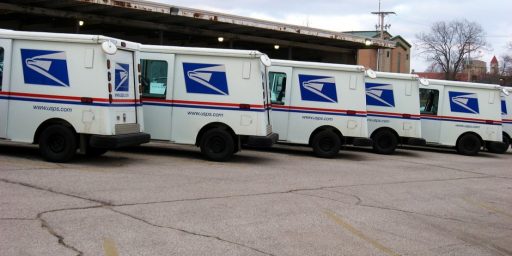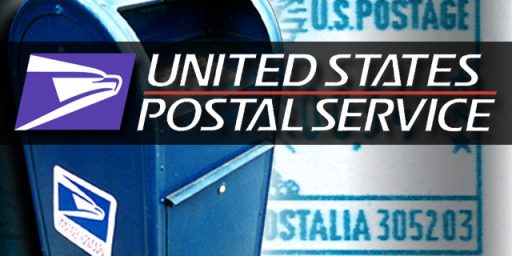Canadian Post Office To Stop Delivering Mail To A Lot Of Canadian Homes
The Canadian Post Office is putting in place reforms that will dramatically change the way many of our neighbor to the north receive their mail:
WATERLOO, Ontario — Canada’s postal service said Wednesday that it would cease home delivery over the next five years, and substantially increase postal rates.
Though Canada would become the first Group of 7 country to end all residential mail delivery in cities and older suburbs, Canada Post shares many problems with postal services in the United States and elsewhere, including rapidly declining mail volumes and high wage and pension costs. Along with the service cuts, the government-owned service said it would eliminate 8,000 jobs, mostly through attrition.
“A leaner work force will create a more flexible and competitive Canada Post,” the post office announced in the summary of a five-point plan. “Canada Post has a mandate to fund its operations with revenues from the sale of its products and services, rather than become a burden on taxpayers.”
In place of home delivery, Canadians who live in cities would have to pick up their mail and parcels at so-called community mailboxes, which would be established in neighborhoods across the nation. (Apartment-dwellers would continue to pick up their mail in their buildings.)
While the service argued that the communal boxes had “advantages for busy Canadians,” the announcement was swiftly and widely criticized by opposition politicians and labor leaders, who noted that the price of a stamp bought in a booklet would increase, to 85 cents from 63 cents.
Justin Trudeau, the Liberal Party leader, criticized the post office for taking such a major step without any advance notice or discussion with customers.
The leader of the Canadian Union of Postal Workers, Denis Lemelin, called the cutbacks and the rise in postage rates “shortsighted and foolish.”
“We are sure we are not alone in disagreeing with Canada Post’s plan,” Mr. Lemelin said in a statement on the union’s website. “C.U.P.W. will stand with those people who resist the elimination of door-to-door delivery.”
Reactions on social media were blunter, pointing out the difficulties that the end of delivery would bring for older and disabled people and suggesting that Canada Post had condemned itself to irrelevancy.
“Canada Post to stop delivering mail to save costs?” Paul Nixey, a communications consultant in Vancouver, British Columbia, asked on Twitter. “Isn’t that a bit like Starbucks no longer serving coffee because it’s expensive?”
Whatever the economic merits of the decision, Dwayne Winseck, a communications professor at Carleton University in Ottawa, said the end of postal delivery was a pivotal moment in Canadian history.
“The whole notion of a universal correspondence service is a pretty important one,” he said. “It’s quite a comedown for a national postal system.” While online shopping has increased the number of parcels Canada Post handles, that has been more than offset by the loss of delivering letters, cards, bills and other kinds of mail that now arrive over the Internet. Over all, the number of pieces of mail handled by Canada Post dropped by 23.6 percent from 2008 to 2012.
Some of these reforms, especially the wider use of so-called “community mail boxes” is something that has been mentioned as a potential reform here in the United States to allow the USPS to deal with its own revenue problems and the fact that revenues are only likely to continue to decline as mail volume declines. Indeed, many newer suburban communities have already built these community mail-boxes for residents although obviously the vast majority of Americans still receive their mail delivered to a box of some type located on their property. The advantages of community mail boxes, though, are self-evident in that they make it far easier for postal workers to complete delivery to a large number of customers in a short period of time. Obviously, there will be some up front costs associated with the transition to this type of delivery system, but in the long run it seems likely to save Canada Post substantial time and money. Perhaps it will serve as a model for similar reforms in the United States.
As an aside, it turns out the the USPS and Canada Post share a common history:
The postal system was founded in 1753 by Benjamin Franklin when both Canada and the thirteen colonies were under British rule.
Like all Americans, I was aware of Franklin’s role in creating what became the US Postal Service. I had not realized that what he helped create had also been put in place in Canada before the Thirteen Colonies and what was then British North America were separated by the Revolutionary War.







Living in Canada, everyone I’ve personally talked about it thinks its not a big deal – letter mail just isn’t sent that much anymore. I have heard interviews with some elderly who are worried, but I’m not so sure I trust the selection of the interviewee’s. Currently only a third of Canadians (according to the gov’t) get home delivery at this point anyway, so the change is just completing a process started awhile ago.
My guess is the people it will affect the most are the folks sending out junk mail, because folks won’t bother to pick it up regularly if its not at their door.
I really don’t know the statistics on type, but my mom’s house still has a mail slot in the front door, absolutely forcing a walk by the post man from his vehicle.
In a neighborhood of 1/4 acre lots I’m not sure clusters would make much sense (to get above 3 homes you start to force a long walk), but moving mail slots out to the curb would be a good first step.
And sure, in tightly packed homes clusters seem to work fine.
@john personna:
the long walk would be part of the fitness plan to reduce health insurance rates.
Though a return to the old days of the country store and post office won’t be a bad thing. Good way to keep up with what’s going on.
Nearly all of the new developments the last 25 years have had cluster boxes and it’s no big deal. Unless I am expecting something I usually only go up to mine every 2 or 3 days.Iget and pay all my bills online. I can check the tracking number to see if I am getting via FED X smart post.
Maybe we can use the USPS to force Americans to exercise by walking to the mailbox instead of the government dictating what size of sodas can be sold.
I’d be fine with a uniform rule, that when you move from country lots to city, at some density, you use cluster boxes. And then, yeah, you’d have the door slot people convert, either to cluster or curb box.
I’m not really sure that at 1/4 acre and above clusters buy anything though, a mailman can fill the curb box from his seat, and at that density is doing more driving that filling boxes.
I’m late to this discussion, but isn’t it FAR more efficient overall to have one postal worker come out to deliver mail to adjacent houses, rather than have MULTIPLE people all driving in to pick it up individually? One trip vs. multiple trips. This just seems incredibly short-sighted – yes it’s cheaper for the Post Office, but the savings is completely swamped by the cost to society.
@Franklin: Yes, but if we can force people to pick up their mail by walking the increased activity will improve health, resulting in lower medical costs, resulting in a benefit to society.
/end[tongue-in-cheek]
Heh, yeah, I’m sure they’ll all walk!
@grumpy realist: If people have to walk to pick up their mail, then what are their dogs going to have to bark at?
“If you like your post office, you can keep it. Period”
My parents have had a group mailbox for well over a decade and I knew some folks in a very upscale neighborhood outside of Austin that have had one for roughly 25.
(The trick is probably to mandate that all new developments use such a setup–if it is that way from the beginning, odds are people won’t even care.)
@Steven L. Taylor: In such developments, how would maintenance be handled ? Who would be paying for maintenance of the mail centers?
Related to this , I used to live in a large apartment complex that had eight of the group mailboxes. They were nice: well lit and enclosed, with a copier and tables. People were always going through the garbage cans looking for coupons. I was amazed at all the stuff people throw away: magazines, all kinds of samples, and packages. I once found a box containing a set of a collection of books by a best selling author – and hardback at that. There were tons of calendars, free calculators, free clock radios, and a few jackets from sports magazines. I was also shocked at the personal information that people throw away. The other amazing thing was the tons of paper that all that advertising uses and winds up in the garbage!